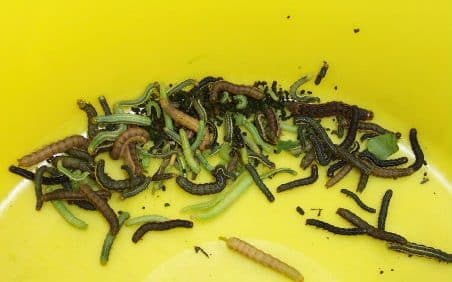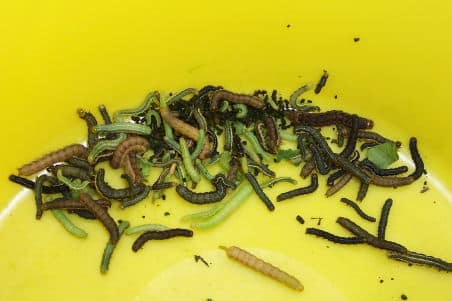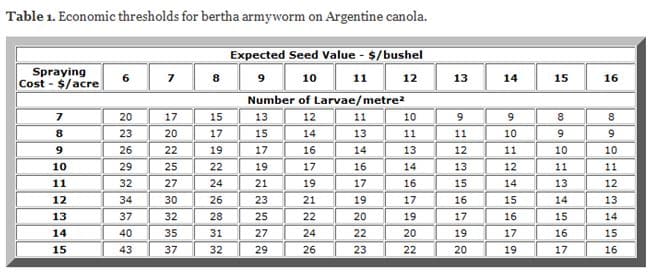Bertha armyworm spraying has been reported in a few fields. Scout lower in the canopy this week, looking for larvae feeding on lower leaves. Scouting now will give you a couple weeks’ planning time before leaf drop begins and berthas start moving up toward the pods — where they do their most costly damage. By holding off until bertha larvae reach pods, you also give various natural controls — such as disease, beneficial insects and weather — to reduce the population and perhaps eliminate the threat.
Bertha armyworms can be green, brown or black. Each has a light brown head and a yellowish-orange stripe down each side. Black larvae also have three narrow, broken white lines on their backs.
It takes about a week for eggs to hatch, and then about 6 weeks for larvae to go through their growth stages and then pupate. Full size is about 1.5” long. When berthas are 3/4” long or longer and have moved up the plant, take counts and be prepared to spray.
If canola is $12 per bushel and control (insecticide and application) costs $12 per acre, the economic threshold is 17 larvae per square metre. At that number control only just pays for itself – no incremental gain. Control costs applied at counts higher than 17 are more likely to provide some return on investment. Research has shown that 20 bertha armyworms per metre squared can reduce yield by 1.16 bushels per acre. The table below (Source: MAFRI) provides thresholds for various canola price and control cost scenarios.
Once the decision to spray is made, check the pre-harvest interval on the chosen insecticide. If the PHI is 21 days, for example, the product has to be applied 21 days or more before the crop is swathed or straight combined.
Click here to link to MAFRI’s bertha armyworm factsheet.
Bertha armyworm scouting tips
—It is easiest to locate the larvae in early morning or in the evening when they are up feeding on the plants. Scout thoroughly, larvae will hide under leaf litter and in cracks, so remove litter, wait a minute for the worms to begin moving and the count carefully.
—Mark out an area a quarter-metre squared (50 cm by 50 cm) and beat the plants growing within that area to dislodge the larvae. Count the larvae that have fallen to the ground and multiply by 4 to get the number per metre square. Larvae will hide under leaf litter and in cracks, so check closely.
—Sample at least 5 locations (10-15 is recommended) a minimum of 50 metres apart. Do not sample headlands and areas within the crop that are not representative of the field. Use the average number of larvae at the sites surveyed to determine if the economic threshold has been exceeded.
—Scout each field. Adjacent fields may have very different larval densities, depending on how attractive the crop was when the moths were laying their eggs. Adjacent fields may also have different-sized larvae, depending on when the eggs were laid.
— For best results, apply an insecticide once you’ve confirmed the field has passed the economic threshold. A single well-timed application of any registered insecticide is usually effective. Check provincial crop protection guides for registered insecticides.
—Apply insecticides early in the morning or late evening when the larvae are actively feeding. Do not apply during the heat of the day. There have been reports of spray applications not being effective because they were made mid-day when the larvae were low in the canopy hiding under debris or in soil cracks.
—Read and follow instructions on product labels. Pay particular attention to pre-harvest intervals (PHI’s).


